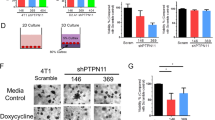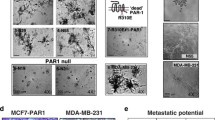Abstract
Increased urokinase plasminogen activator (u-PA) production is associated with tumor invasion and metastasis in several malignancies, including breast cancer. The mechanisms underlying constitutive u-PA expression are not well understood. We examined the relationship between the signal strength of the ERK pathway and the level of u-PA expression in the metastatic human breast cancer cell line MDA-MB-231. Treatment with the MEK1 inhibitor PD98059 resulted in decreased ERK1/2 phosphorylation and decreased u-PA mRNA and protein expression. Inhibition of ERK1/2 activity also led to decreased cell proliferation and to decreased cyclin D1 expression. Less than 5% of total ERK1/2 was phosphorylated in exponentially growing MDA-MB-231 cells, and ERK1/2 activity could be stimulated by okadaic acid. Okadaic acid did not stimulate u-PA expression, but induced strong expression of the cdk-inhibitor p21Cip1. These findings suggest that ERK1/2 signaling is tuned to a level which results in high u-PA expression and rapid cell proliferation.
Similar content being viewed by others
References
Liotta LA, Stetler-Stevenson WG. Tumor invasion and metastasis: an imbalance of positive and negative regulation. Cancer Res 1991; 51: 5054s–9s.
Mignatti P, Rifkin DB. Biology and biochemistry of proteases in tumor invasion. Physiol Rev 1993; 73: 161–95.
Lindblom A, Linder S. The metastatic phenotype-prognostic implications. Crit Rev Oncol/Hematol 1996; 24: 71–96.
Carmeliet P, Schoonjans L, Kieckens L et al. Physiological consequences of loss of plasminogen activator gene function in mice. Nature 1994; 368: 419–24.
Andreasen P-A, Kjøller L, Christensen L, Duffy MJ. The urokinasetype plasminogen activator system in cancer metastasis: A review. Int J Cancer 1997; 72: 1–22.
Reuning U, Magdolen V, Wilhelm O et al. Multifunctional potential of the plasminogen activation system in tumor invasion and metastasis. Int J Oncol 1998; 13: 893–906.
Lengyel E, Stepp E, Gum R et al. J Biol Chem 1995; 270: 23007–12.
Lengyel E, Gum R, Stepp E et al. Involvement of a mitogen-activated protein kinase signaling pathway in the regulation of urokinase promoter activity by c-Ha-ras. Cell Biochem 1996; 61: 430–43.
Watabe T, Yoshida K, Shindoh M et al The Ets-1 and Ets-2 transcription factors activate the promoters for invasion-associated urokinase and collagenase genes in response to epidermal growth factor. Int J Cancer 1998; 77: 128–37.
Janulis M, Silberman S, Ambegaokar A et al. Role of mitogenactivated protein kinases and c-Jun/AP-1 trans-activating activity in the regulation of protease mRNAs and the malignant phenotype in NIH 3T3 fibroblasts. J Biol Chem 1999; 274: 801–13.
Davis RJ. Transcriptional regulation by MAP kinases. Mol Reprod Dev 1995; 42: 459–67.
Woodgett JR, Avruch J, Kyriakis J. The stress activated protein kinase pathway. Cancer Surv 1996; 27: 127–38.
Russell M, Lange-Carter CA, Johnson GL. Direct interaction between Ras and the kinase domain of mitogen-activated protein kinase kinase kinase (MEKK1). J Biol Chem 1995; 270: 11757–60.
Ghiso JAA, Alonso DF, Farias EF et al. Deregulation of the signaling pathways controlling urokinase production – its relationship with the invasive phenotype. Eur J Biochem 1999; 263: 295–304.
Holst-Hansen C, Johannessen B, Hoyer-Hansen G et al. Urokinasetype plasminogen activation in three human breast cancer cell lines correlates with their in vitro invasiveness. Clin Exp Metastasis 1996; 14: 297–307.
Thompson EW, Paik S, Brunner N et al. Association of increased basement membrane invasiveness with absence of estrogen receptor and expression of vimentin in human breast cancer cell lines. J Cell Physiol 1992; 150: 534–54.
Lee FS, Hagler J, Chen ZJ, Maniatis T. Activation of the IκBαkinase complex by MEKK1, a kinase of the JNK pathway. Cell 1997; 88: 213–222.
Molin M, Shoshan MC, Öhman K et al. Two novel adenovirus vector systems permitting regulated protein expression in gene transfer experiments. J Virol 1998; 72: 8358–61.
Heid CA, Stevens J, Livak KJ, Williams PM. Real time quantitative PCR. Genome Res 1996; 6: 986–94.
Zhou JN, Ljungdahl S, Shoshan M et al. Activation of tissue factor gene expression in breast carcinoma cells by stimulation of the RAFERK signalling pathway. Mol Carcinogen 1998; 21: 234–43.
Pages G, Lenormand P, L'Allemain G et al. Mitogen-activated protein kinases p42mapk and p44mapk are required for fibroblast proliferation. Proc Natl Acad Sci USA 1993; 90: 8319–23.
Liu J-J, Chao J-R, Jiang M-C et al. Ras transformation results in an elevated level of cyclin D1 and acceleration of G1 progresison in NIH 3T3 cells. Mol Cell Biol 1995; 15: 3654–63.
Lloyd AC, Obermüller F, Staddon S et al. Co-operating oncogenes converge to regulate cyclin/cdk complexes. Genes Dev 1997; 11: 663–77.
Sewing A, Wiseman B, Lloyd AC, Land H. High intensity Raf signaling causes cell cycle arrest mediated by p21Cip1. Mol Cell Biol 1997; 17: 5588–97.
Alblas J, Slager-Davidov R, Steenbergh PH et al. The role of MAP kinase in TPA-mediated cell cycle arrest of human breast cancer cells. Oncogene 1998; 16: 131–9.
D'Orazio D, Besser D, Marksitzer R et al. Cooperation of two PEA3/AP1 sites in uPA gene induction by TPA and FGF-2. Gene 1997; 201: 179–87.
Miralles F, Parra M, Caelles C et al. UV irradiation induces the murine urokinase-type plasminogen activator gene via the c-Jun N-terminal kinase signaling pathway: Requirement of an AP-1 enhancer element. Mol Cell Biol 1998; 18: 4537–47.
Xing RH, Rabbiani SA. Transcriptional regulation of urokinase (uPA) gene expression in breast cancer cells: role of DNA methylation. Int J Cancer 1999; 81: 443–50.
Ljungdahl S, Linder S, Sollerbrandt K et al. Signal transduction in fibroblasts stably transformed by [Val12]Ras. The activities of extracellular-signal-regulated kinase and Jun-N-terminal kinase are only moderately increased, and the activity of the δ-inhibitor of c-Jun is not alleviated. Eur J Biochem 1997; 249: 648–56.
Ravi RK, Weber E, McMahon M et al. Activated Raf-1 causes growth arrest in human small cell lung cancer cells. J Clin Invest 1998; 101: 153–9.
Hazzalin CA, Cuenda A, Cano E et al. Effects of the inhibition of p38/RK MAP kinase on induction of five fos and jun genes by diverse stimuli. Oncogene 1997; 15: 2321–31.
Tombes RM, Auer KL, Mikkelsen R et al. The mitogen-activated protein (MAP) kinase cascade can either stimulate or inhibit DNA synthesis in primary cultures of rat hepatocytes depending upon whether its activation is acute/phasic or chronic. Biochem J 1998; 330: 1451–60.
Irigoyen JP, Besser D, Nagamine Y. Cytoskeleton reorganization induces the urokinase-type plasminogen activator gene via the Ras/extracellular signal-regulated kinase (ERK) signaling pathway. J Biol Chem 1997; 272: 1904–9.
Marshall CJ. Specificity of receptor tyrosine kinase signaling: transient versus sustained extracellular signal-regulated kinase activation. Cell 1995; 80: 179–85.
Author information
Authors and Affiliations
Rights and permissions
About this article
Cite this article
Seddighzadeh, M., Zhou, JN., Kronenwett, U. et al. ERK signalling in metastatic human MDA-MB-231 breast carcinoma cells is adapted to obtain high urokinase expression and rapid cell proliferation. Clin Exp Metastasis 17, 649–654 (1999). https://doi.org/10.1023/A:1006741228402
Issue Date:
DOI: https://doi.org/10.1023/A:1006741228402




